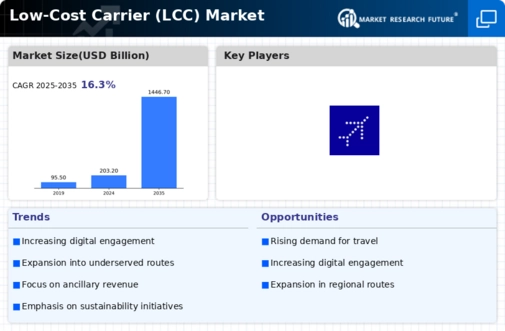Top Industry Leaders in the Low Cost Carrier Market

Strategies Adopted:
Cost Efficiency: LCCs prioritize cost control measures, including point-to-point routes, high aircraft utilization, and minimal in-flight services, to offer lower fares.
Ancillary Revenue: Many LCCs generate significant revenue through ancillary services such as baggage fees, seat selection, and onboard sales, supplementing their fare income.
Fleet Simplification: Standardizing fleet types, often consisting of single-aisle aircraft like the Boeing 737 or Airbus A320 family, enables LCCs to streamline operations and reduce maintenance costs.
Digital Innovation: Embracing digital technologies for ticket sales, customer service, and marketing allows LCCs to enhance efficiency, improve customer experience, and lower distribution costs.
Key Companies in the Low-Cost Carrier (LCC) Market include
EasyJet Airline Company Limited (UK)
AirAsiaBerhad (Malaysia)
JetBlue Airways Corporation (US)
IndiGo (India)
Ryanair DAC (Ireland)
Norwegian Air Shuttle ASA (Norway)
SpiceJet Limited (India)
Southwest Airlines Co (US)
WestJet Airlines Ltd (Canada)
Spirit Airlines Inc(US).
Factors for Market Share Analysis:
Route Network: The breadth and depth of route networks influence market share, with LCCs expanding into new markets and increasing frequencies on popular routes to capture passenger demand.
Pricing Strategy: Competitive pricing relative to legacy carriers and other LCCs plays a crucial role in attracting budget-conscious travelers and gaining market share.
Customer Satisfaction: Positive passenger experiences, including on-time performance, service quality, and overall value proposition, contribute to customer retention and market share growth.
New and Emerging Companies:
IndiGo: India's largest LCC, IndiGo, has rapidly expanded its domestic and international operations, leveraging its low-cost model and strong market position.
JetBlue Airways: While originally positioned as a hybrid carrier, JetBlue has increasingly adopted LCC strategies, focusing on cost containment and network expansion.
Wizz Air: A leading LCC in Central and Eastern Europe, Wizz Air has capitalized on growing demand for low-cost travel in the region, expanding its presence and fleet size.
Industry News and Current Company Investment Trends:
Expansion into New Markets: LCCs are eyeing opportunities in underserved or emerging markets, including secondary cities and leisure destinations, to stimulate demand and sustain growth.
Fleet Modernization: Many LCCs are investing in new, fuel-efficient aircraft to reduce operating costs, enhance reliability, and lower emissions, supporting long-term sustainability goals.
Partnerships and Alliances: Collaborations between LCCs and other airlines, as well as with travel agencies and technology providers, are increasing to expand reach, improve connectivity, and enhance the overall travel experience.
Overall Competitive Scenario:
The LCC market remains fiercely competitive, driven by ongoing price wars, capacity expansion, and evolving consumer preferences. While established players continue to dominate key regions, new entrants and emerging markets present opportunities for growth and innovation. With the industry facing challenges such as fluctuating fuel prices, regulatory changes, and economic uncertainty, LCCs must remain agile and adaptive to maintain their competitive edge in the dynamic aviation landscape.











